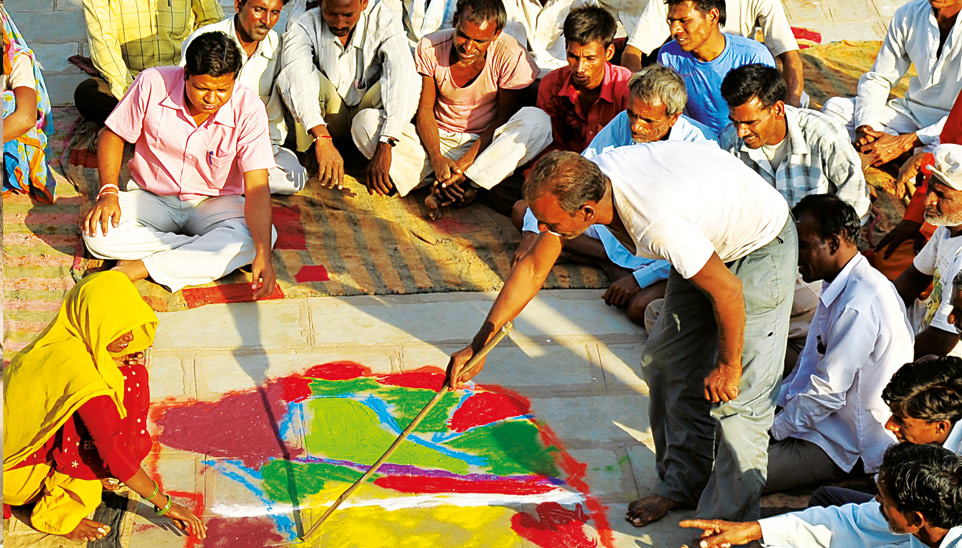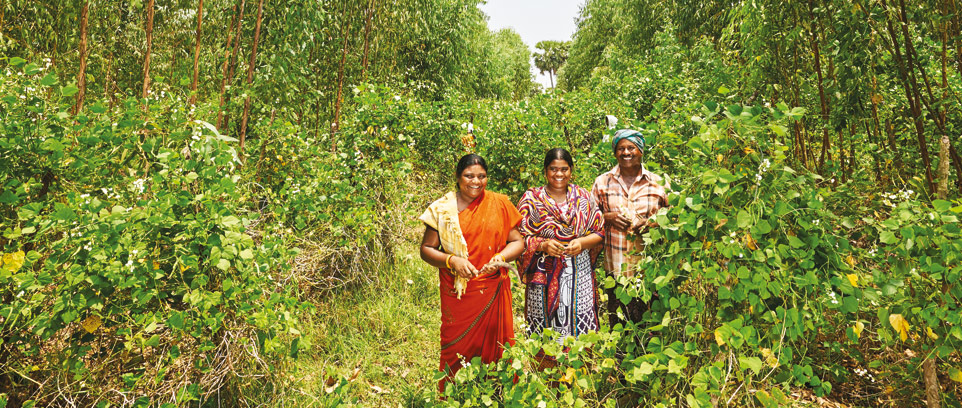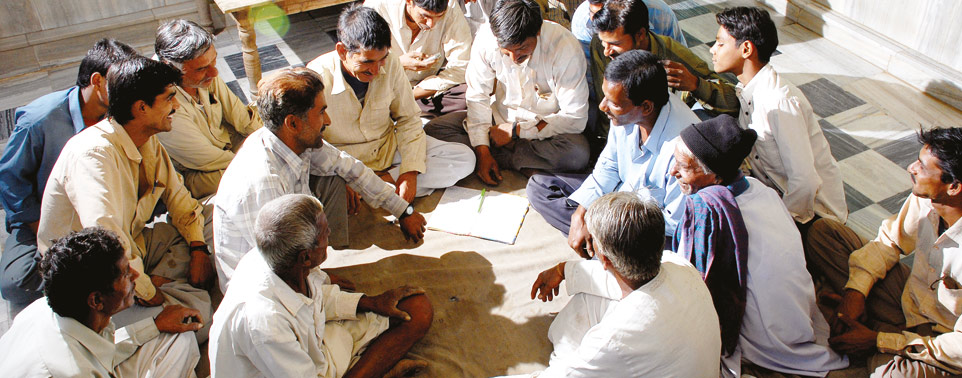 Environment
Environment Economic
Economic

In line with the Company's Board approved policy on stakeholder engagement, ITC has a structured framework to engage with stakeholders and address their key concerns. The framework is based upon established long-term relationships with key stakeholders such as shareholders, farmers, customers, suppliers, employees, local communities, regulatory bodies and the media. With the firm belief that stakeholder engagement is an integral part of enriching and enduring partnerships, ITC has institutionalised these processes grounded on transparency and accountability.
Since ITC's holistic development approach demands an intensive and deep level of engagement, it is necessary to identify and delineate the felt needs and aspirations of our stakeholder communities in new locations and to gauge the extent to which the current set of interventions were valued by the communities and evaluate if any course correction was required in ongoing project locations. A comprehensive stakeholder engagement was undertaken in 2015-16 comprising 483 Participatory Rural Appraisals (PRA) covering more than half of the total core villages/habitations.
The major finding was that ITC's stakeholders are confronted with multiple, but inter-related issues at the core of which are the twin challenges of securing sustainable livelihoods today and tomorrow.
In 2016-17, such exercises were carried out in 3 new project districts of Pali (Rajasthan), Jalukbari (Assam) and Sukma (Chhattisgarh), covering 19 villages. The process included secondary research, discussions held with individual farmers, Focus Group Discussions with village communities and PRAs to understand the development challenges confronting them. The insights from the 2016- 17 engagements were largely congruent with those of the 2015-16 assessment. However, a few specific issues that surfaced, pertinent for the district under consideration, have been described below:

In addition to discussions with stakeholder communities, ITC is also committed to anchoring a wider network of relevant stakeholders like the governments, development agencies and research organisations. Such multi-disciplinary collaborations stimulate deeper and nuanced understanding of challenges and enable the emergence of customised solutions. Several such stakeholder consultations were held during the year, detailed below:

The sensitivity of an issue to a stakeholder and to ITC, in terms of high/medium/ low importance forms the basis of the materiality analysis which in turn leads to identification of material aspects, definition of management approach and specific action plans for addressal.
Please refer to the Materiality Analysis section for further details on ITC's response to key stakeholders' concerns.

As a diversified enterprise, ITC continues to focus on a system-based approach to business risk management. The Corporate Risk Management Cell, through focused interactions with businesses, facilitates the identification and prioritisation of strategic and operational risks, development of appropriate mitigation strategies and conducts periodic reviews of the progress on the management of identified risks. The annual planning exercise requires all Businesses to clearly identify their top risks and set out a mitigation plan with agreed timelines and accountability. The senior management of the Company also periodically review the risk management framework to keep it contemporary and relevant so as to effectively address the emerging challenges in a dynamic business environment.
Based on the ongoing risk assessments at Businesses level and aggregated at the organisation level, ITC has classified its sustainability challenges into two broad categories - those that are influenced by global events, and challenges that are unique to India.
According to the World Economic Forum (WEF) Report on Global Risks 2017, largescale migration, extreme weather events, major natural disasters, water crises and failure of climate-change mitigation and adaptation, weapons of mass destruction, and large-scale terrorist attacks are amongst the top risks that plague the world today.
Some of these top most risks that endanger the world today are short-term and arise as a direct outcome of human action including weapons of mass destruction, large-scale terrorist attacks and mass migration.
Continuing with the trend last year, Europe witnessed large-scale involuntary migration from Middle East, Africa, South Asia and the Western Balkans fleeing war and persecution, poverty and lack of employment in their home countries. In addition to high refugee inflows, stability within the European Union is further threatened by stagnating economies and growth of far-right political parties. Other factors such as extreme energy price volatility will further aggravate these stresses.
In addition, the world today faces the growing concern of unemployment and underemployment contributing to rising socio-economic inequality. This is reflected by the fact that the richest 1% had accumulated more wealth than the rest of the world put together1.
Food crises is another challenge that threatens the world today. While the rising world population requires food production to be increased by 70% by 2050 to meet the growing demand, every year land equal to the size of Ice-land1 is affected due to top soil erosion. Further, changing weather patterns and shortage of freshwater will further aggravate the food crises.
1According to Global Opportunities Network Report 2017
The list for long-term global risks is dominated by those related to physical and environmental issues such as climate change and water security. The world will not be able to meet the sustainable development challenges of the 21st century - human development, liveable cities, food security and energy security - without improving management of water resources and ensuring reliable access to water. Rising urban population, coupled with poor planning and rising income levels, has placed unprecedented pressure on urban infrastructure including water supply network. As per 2030 Water Resources Group Report, with current practices the world will face a 40% shortfall between forecast demand and available supply of water by 2030. Risk of extreme weather events and failure to adapt to climate change will further exacerbate crises leading to rapid increase in other interconnected risks such as conflicts and large-scale migrations. It was highlighted in the WEF Global Risk Report 2017. Global risks transcend borders and spheres of influence, which require all stakeholders to work together. The anticipated and real impacts of the above issues amongst developed and developing countries are however vastly different, both in scale and scope. These differences are multi-layered and multi-faceted given the dimensions of the challenges and the socio-economic context in different countries. Countries like India while cognising the larger global challenges, will have to shape their own sustainability agenda with focus on specific issues that have an immediate and direct impact on the Indian society at large.

While India echoes many of the global challenges, issues like poverty, social inequities, unemployment, environmental degradation, water and food crises assume even more critical and multi-dimensional characteristics in India. Land pressure for instance, assumes greater significance in India which is home to 18% of the world's population, with only 2.3% of the world's land share.
India Inc. is faced with serious challenges due to water crisis. While agriculture accounts for around three quarters of all water used in India, rapid urbanisation and increasing demand from commercial and industrial users have added to the stress on already fragile water resources. According to a 2030 Water Resources Group Report2, India would face 50% aggregate gap between projected demand and existing water supply in 2030 due to high growth in agricultural, municipal and domestic demand. Despite substantial rise in demand, India's water supply remains constrained owing to inefficient use of water, over exploitation of ground water reserves without adequate recharge and variations in surface water availability because of erratic rainfall patterns.
Agriculture and allied activities remain the major source of livelihood for nearly half of the Indian population. The share of agriculture in employment was 48.9% of the workforce, while its share in the Gross Domestic Product (GDP) was 17.4% in 2014-153. However, deteriorating natural resource base, disconnected value chains, fragmented and small-size landholdings, weak infrastructure, inadequate knowledge and multiple intermediaries are the main reasons for low income among the average farmers. Furthermore, around 55% of India's total sown area meets its requirements from rainwater alone4. This assumes importance in the face of climate change related challenges of erratic rainfall leading to drought and floods. A majority of the farmers are hence trapped in a vicious cycle of low productivity. Therefore, there is a need to address these challenges by ensuring farming population's sustainable access to water, knowledge and other necessary resources, whilst simultaneously improving the productivity resulting in better income realisation. The surplus workforce from the agriculture sector can be provided with adequate skill training to enable them to join the manufacturing sector strengthening the Government of India's 'Make in India' campaign.
A landmark agreement amongst countries to address climate change challenge was signed in Paris in December 2015 to limit the global temperature rise to below 2°C and work towards adaptation. Subsequent to the ratification of the Paris agreement by major countries, the climate change agreement gained momentum in the Conference of Parties (COP-22) at Morocco with focus shifting to higher commitments and creation of an implementation framework. India, through ratification of the Paris agreement, has agreed to abide by its commitments under Nationally Determined Contributions (NDC) to UNFCCC. India's commitments are focusing on voluntary targets of reducing emissions intensity, increasing the share of non-fossil based electricity, and creating additional carbon sinks. All these in turn would imply targeted interventions from the various industrial sectors of India. India's aim to reduce its emissions intensity by 30-35% by 2030 through various programmes such as renewable energy, and energy efficiency would in turn imply specific targets for reduction in GHG emissions intensity for the various industrial sectors. As sector specific targets would become a reality sooner or later, Indian industries need to revisit their individual GHG contribution with representative projection till 2030 and adopt a low carbon growth trajectory. In addition, Indian industry sector would also face significant challenges due to price volatility in the global energy market, which may hamper investments into the renewable energy projects.
As a growing economy, India has to deal with the problems of rapid and unplanned urbanisation. Increasing population, higher consumption levels and inadequate infrastructure are putting a severe strain on the ecology. A large amount of waste being generated today ends up in landfills, leading to serious concerns of public health and sanitation risks as well as large-scale environmental degradation. Negative impacts of urbanisation are also manifest in the pollution of almost all Indian rivers that have been absorbing domestic and industrial sewage and agricultural wastes over the last few decades. Apart from posing a serious health problem to millions of people that continue to depend on polluted water from rivers, this also endangers the biodiversity dependent on it. It is therefore the need of the hour for the country to invest in basic infrastructure. This will further require enormous resources that can only be generated with a larger focus on livelihood creation and widening of the tax base.
In the light of rapid urbanisation, road safety has also emerged to be a growing and alarming national concern. Over the years, the significant growth of vehicles on Indian roads has been the leading cause of accidents resulting in deaths, disabilities and hospitalisations with severe socio-economic costs across the country. According to a report by the Transport Research Wing of Ministry of Road Transport and Highways, Government of India, during the year 2014, there were around 4.89 lakhs road accidents with about 1.4 lakh fatalities and injuring more than 4.93 lakh persons in India. Such numbers strongly indicate not only the need for improving the emergency medical aid and road infrastructures but also the need to spread mass awareness on behavioural safety.
2Charting our Water Future, Report by 2030 Water Resources Group, 2009
3Economic Survey 2015-16
4Prioritisation of Rainfed Areas in India, Planning Commission Report, February 2012
ITC's operations and markets are India centric and the Company's world-class Indian brands ensure that larger value is created, captured and retained in the country for national development and growth. Therefore, the Organisation's sustainability is closely driven by the country's advantages and vulnerabilities. In line with the risks and opportunities that may impact India's economic, social and environmental sustainability, ITC has mapped the key challenges, risks and opportunities that are likely to impact its own long-term prospects and those of its stakeholders.

ITC's Materiality matrix enabled the design of the content of this Report so as to provide a reasonable and balanced picture of the Organisation's Triple Bottom Line impacts and its performance. ITC's materiality analysis is based upon the following three pronged approach.
The matrix on the next page depicts the material aspects based on their influence and significance on stakeholders' perception and ITC's impacts. The categorisation under low, medium & high demonstrates the relative importance of aspects and does not necessarily depict that a particular aspect rated as 'low' has low impact or relevance.